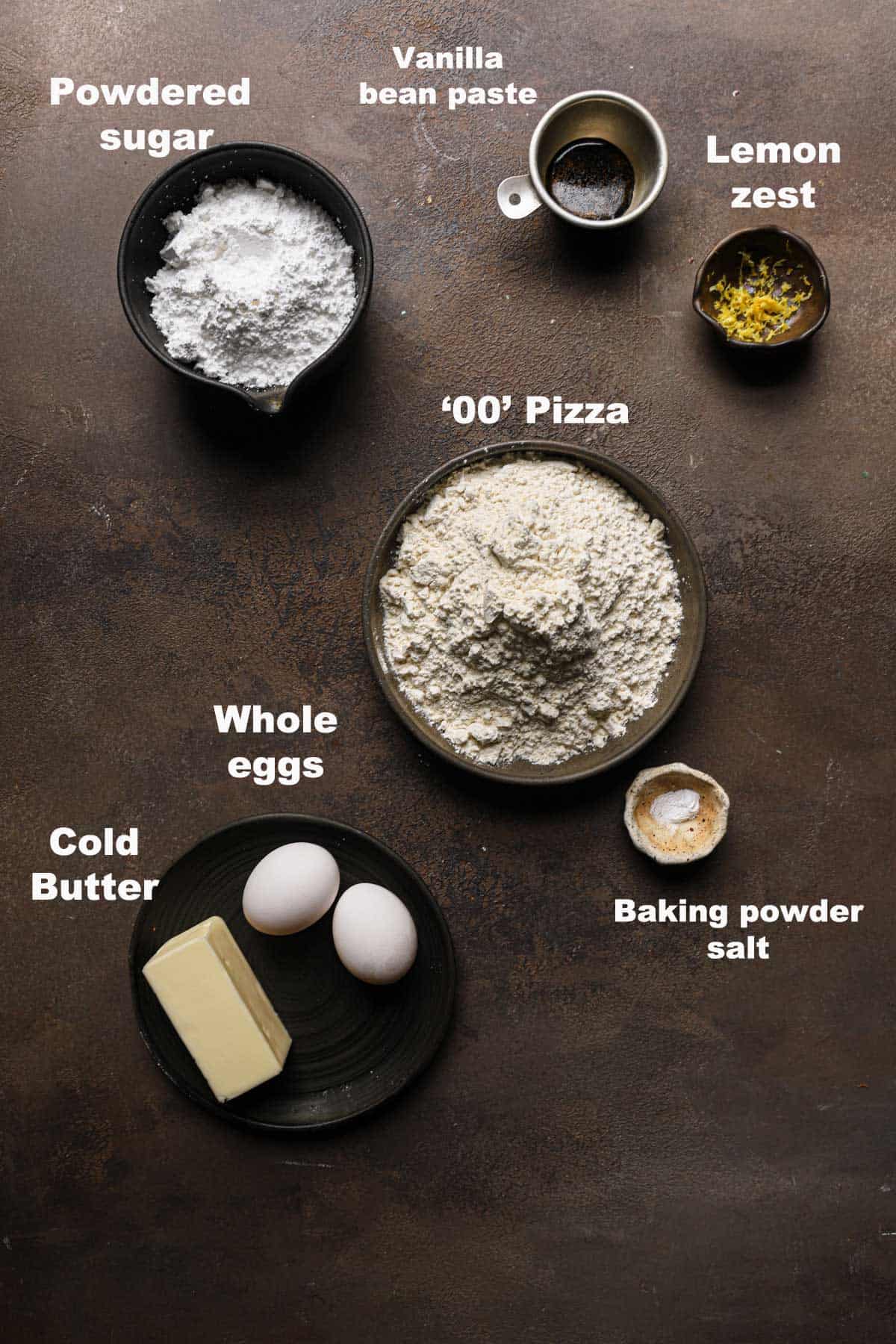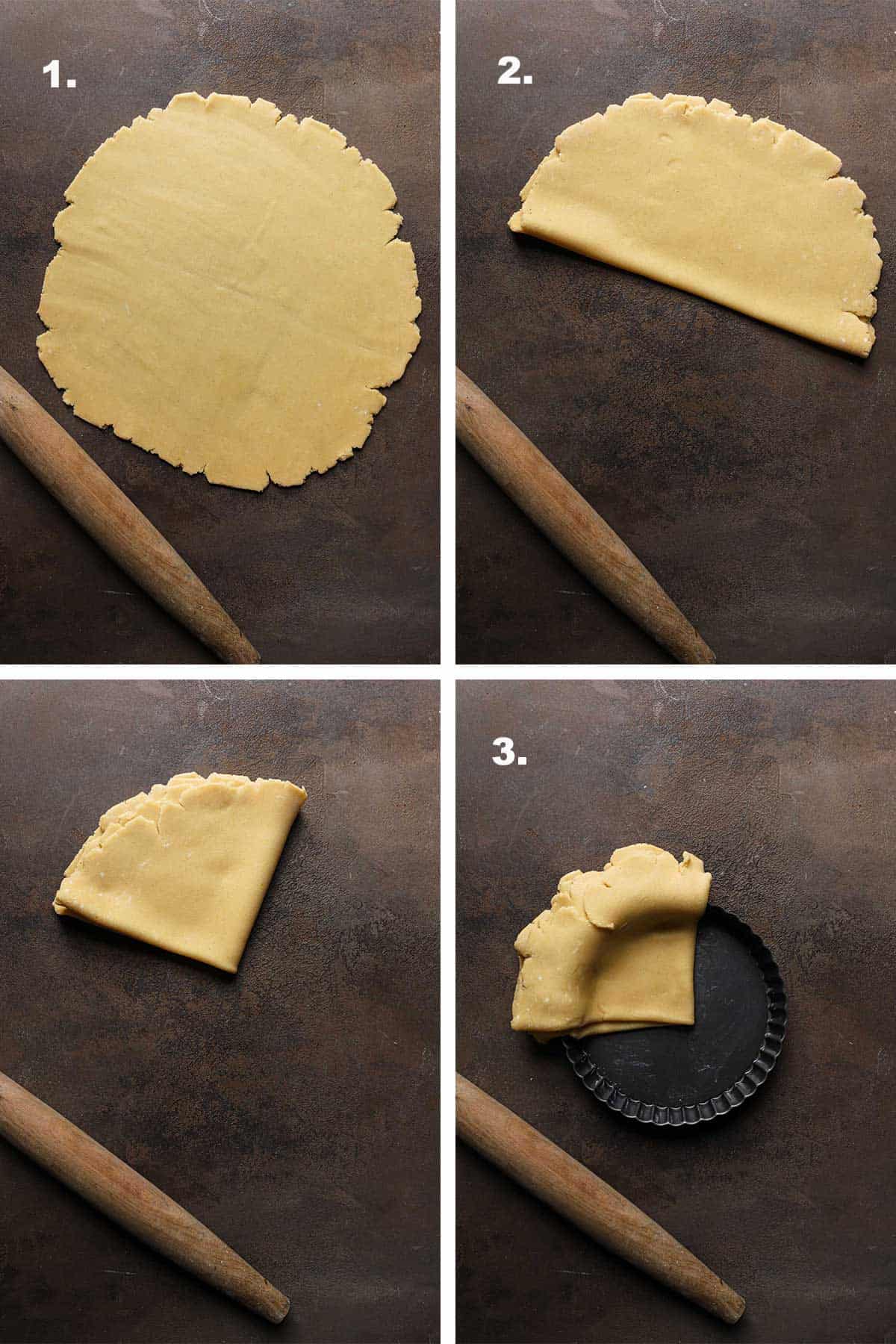Last updated on June 11th, 2025.
When it comes to Italian baking, one of the foundational recipes you need to master is Italian Pasta Frolla, what we all know as Shortcrust Pastry. This versatile buttery shortcrust pastry is the basic recipe for many classic Italian desserts, from crostata (tarts) to Torta Della Nonna. In this guide, we’ll delve into what Pasta Frolla is, how it differs from Pâte Sablée, its ingredients, and step-by-step instructions on how to make it.
This post contains affiliate links; check out our Disclosure Policy for more information.

Pasta Frolla is Italy’s version of shortcrust pastry, used for strawberry crostata, tarts, and cookies. It’s buttery, slightly crumbly, and easy to work with.
Pasta Frolla vs. Pâte Sablée
Though similar in ingredients, Pasta Frolla and Pâte Sablée differ in fat content and technique. The French version uses about 60% butter to flour, yielding a more fragile, crumbly texture. Pasta Frolla uses closer to 50% butter and is kneaded into a smooth, pliable dough, making it easier to roll and ideal for structured desserts like Italian style Apple Crostata and Torta Della Nonna.
Key Ingredients
The complete ingredients list, including measurements is at the bottom of this post in the recipe cars.
- ’00’ pizza flour. The ’00’ flour makes a difference in this recipe, which is now very common in most grocery stores. Otherwise, use bleached all-purpose flour.
- Baking powder. Just a pinch to help with the crumbly texture.
- Lemon zest. Its is mostly traditional and adds a light, bright notes to the dough, and it is also optional.
- Cold unsalted butter. Cold butter coats the flour in fat, creating a tender crumb. Room-temperature butter releases water, encouraging gluten and a chewier texture.
- Powdered sugar. Powdered sugar is critical in this recipe and is the best type of sugar for it. Because it contains some potato starch, it will help with the crumbly, tender texture of the dough.
- Vanilla bean paste. Or vanilla extract.

How to Make Pasta Frolla
Below are two ways to make the dough, to make it using a stand mixer, use a grated cold butter and the paddle attachment and follow the food processor’s instructions.
Using the Food Processor
- In the bowl of a food processor, combine the flour, sugar, salt, lemon zest, and baking powder. Pulse once or twice to incorporate.
- Cut the cold butter into 1/2-inch pieces, add it to the dry ingredients, and pulse until the mixture resembles coarse crumbs.
- Beat the eggs and vanilla paste, then add it to the flour mixture and process until a smooth ball of dough is formed.
- Wrap the dough with plastic wrap, press it onto a disk, and refrigerate for at least one hour.

By Hand Method
- Whisk together the flour, sugar, and salt in a large bowl.
- Use a vegetable grater to grate the cold butter over the flour mixture.
- Use your fingers to rub the butter into the flour until it is well incorporated and no dry flour is left. This should take about 1-2 minutes.
- Beat the eggs and vanilla in a separate bowl. Make a well at the center of the bowl and pour in the beaten eggs. Mix the flour into the eggs with a small spatula or a fork.
- Once the mixture is too thick for the spatula, use your hand to bring the ingredients together into a smooth dough.
- Wrap the dough with a cling film, press it into a disk, and refrigerate until used.


Rolling and Transferring the Dough
- Once chilled, using a rolling pin, roll out the dough on a lightly floured surface to your desired thickness. Make sure to rotate the dough 90 degrees after every one or two rolls. (At this point, you can use cookie cutters to cut into cookies and bake.)
- Carefully fold the dough into half, then again into a triangle.
- Lift the dough and place it over a tart pan so the tip of the triangle is at the center of the pan.
- Gently unfold the dough and use your fingers to press it into the bottom and sides of the pan.
- Roll the top of the pan with a rolling pin to remove any access dough. Use the dough according to the recipe instructions.


Blind Bake
Blind baking is sometimes necessary, especially when we fill our tart shell with pastry cream, crema pasticcera, fresh fruit, or other custards.
- Refrigerate or freeze the tart shell lined with the Italian sweet shortcrust pastry dough for 30 minutes before baking.
- Remove the chilled dough from the refrigerator and use a fork to prick the crust.
- Cover the shell with parchment paper and fill it with pie crust or dry beans.
- Bake for 15 minutes at 375F (190C) for par-baked. For full bake, remove the tart from the oven, wait 5-10 minutes, remove the pie crust, and bake for 10-15 minutes. Baking time might change depending on the size and thickness of the dough. The dough is ready when it is medium golden brown for full baking or light-medium par-baked baking.


Flavor Variations
Pasta Frolla can be customized with various flavorings to suit your recipe or preference. Consider adding:
- Almond extract or finely ground almonds
- Replace 15% of the flour with Cocoa powder for a chocolatey twist.
- Use orange zest instead or in addition to the lemon zest.
Tips
- Keep all the ingredients, especially the butter, cold throughout the process to ensure a flaky and tender crust. Room temperature ingredients might result in a very sticky dough, tough dough.
- Don’t overwork the dough, which can result in a tough pastry. Handle it gently and stop kneading once it comes together.
- If the dough becomes too soft or sticky while rolling, place it back in the refrigerator for a few minutes to firm up.
- It is very natural for shortcrust and pie crusts to shrink during blink baking. Ensure there is no gap between the dough and the edges of the pan.
Storing and Making ahead
The dough can be made ahead and refrigerated for up to 3 days, or freeze it for up to 3 months. Thaw frozen dough overnight in the refrigerator before using. If it is too hard to roll, let it warm at room temperature for 10-15 minutes before rolling.
To freeze, wrap it with plastic wrap, place it in a freeze zip bag, and freeze it for up to 6 weeks. Place in the refrigerator the night before when ready to use.
Baked dough and cookies should be stored at room temperature for up to five days. Follow the filling storing instructions if filled or frosted with a perishable filing.

More Tarts Recipes You Might Enjoy
Strawberry Tart, Chocolate Tart, Almond Pear Tart
Pasta Frolla Recipe
Ingredients
- 3 3/4 Cups '00' flour (450g)
- 1/4 teaspoon Baking powder
- 1/2 teaspoon Salt
- 1 Cup Powdered sugar (120g)
- 1 Cup Unsalted butter, cold (225g)
- 2 Large Whole eggs
- 1 teaspoon Vanilla bean paste or extract
- Zest Of half lemon
Instructions
Food Processor Method
- Place the flour, baking powder, salt, and sugar in a bowl of a food processor and pulse 2-3 times.
- Cut the butter into 1/2-inch pieces, add it to the flour mixture, and process until the butter is now tiny pieces.
- Beat the eggs with the vanilla paste, add it to the butter/flour mixture, and process until a smooth dough is formed.
- Wrap the dough with plastic wrap, press it into a disk, and refrigerate for a minimum of 30 minutes or up to three days.
Bowl Method
- Mix the flour, baking powder, salt, and sugar in a large bowl using a fork.
- Grate the butter using a vegetable grader, add it to the dry ingredients, and use your fingers to rub the butter into the flour mixture.
- Beat the eggs with the vanilla bean. Make a well at the center of the bowl, then pour the beaten eggs into the well.
- Use a spatula or a fork to gradually mix the eggs into the flour, starting from the center.
- Once the eggs have been incorporated into the flour mixture, use your hand to bring the dough together.
- Wrap the dough in plastic wrap, press it into a disk, and refrigerate for a minimum of 30 minutes or up to 3 days.
Rolling and handling the dough
- Remove the dough from the refrigerator, unwrap it, and roll it into a 12-inch circle over a lightly floured work surface.
- Fold the dough in half, then again, so you will end up with a triangle.
- Gently lift the dough and place it over a nine-inch tart pan so the tip of the triangle is at the center of the pan.
- Gently unwrap the triangle, then use your fingers to press the dough into the sides of the pan.
- Roll your rolling pun over the top of the pan to remove dough access.
Blind Baking
- Preheat the oven to 375F (190C) and place a baking sheet on the bottom rack.
- Use a fork to prick the bottom of the dough, and place a piece of parchment paper on top.
- Fill the tart shell with pie weights or dry beans and bake for 15 minutes.
- Remove from the oven, and allow the tart to chill for about 10 minutes before removing the weights.
- Remove the pie weights, and return the tart shell to the oven for an additional 5 minutes for a par-baked crust. Or 10-12 minutes for fully baked.
- Remove from the oven and allow to cool completely before filling.
Notes
- Unbaked dough can be refrigerated for up to two days.
- To freeze, place the wrapped dough in a freezer bag and freeze for up to six weeks. When ready to use, refrigerate overnight to allow it to defrost.
- Don’t overwork the dough; once it comes together, stop and wrap it.
- Blind baking it for unbaked filling such as custard and fresh fruit.


